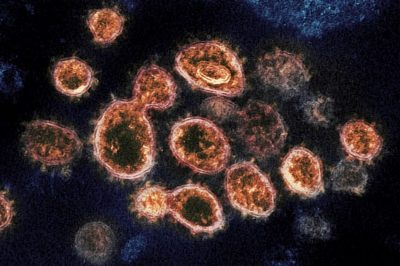Coronavirus and Other Deadly Outbreaks of the Past
Share

This scanning electron microscope image shows COVID-19 (round blue objects) emerging from the surface of cells cultured in the lab. (NIH Image Gallery / Flickr)
At a global level, all countries are fighting the same monster—COVID-19. COVID-19 is an infectious disease caused by a coronavirus. WHO has declared it a pandemic due to its reckless spread and increased fatality with no cure in sight. The first outbreak was reported in Wuhan City of China in 2019, and since then there have been more than 249,110 confirmed cases over the world. With the highest death toll surge in Italy, Europe has been confirmed as the epicentre of COVID-19.
COVID-19 and its effects
WHO classifies coronaviruses as zoonotic viruses i.e., they are transmitted to humans via infected animals. And further person-person transmission is through air droplets, hence close contact with infected people/carriers is to be avoided.
In its initial stages, it remains asymptomatic for at least 12-14 days. Following the incubation period it affects the respiratory system, starts with flu and when left untreated or in adverse cases causes pneumonia, kidney failure and death. Immunocompromised people i.e., those with a history of chronic diseases such as cardiovascular diseases, cancer, diabetes, pulmonary diseases etc. are at a higher risk along with pregnant women and those above the age of 50.
Tackling the virus
As this is a new viral strain—SARS-CoV-2 and has never been seen before in animals or humans, antiviral drugs are impotent to fight and control the spread. Thus to tackle this deadly disease, the current strategy being used is “prevention is better than cure”.

Ukraine evacuating Ukrainianfrom Wuhan, China. (State Border Guard Service of Ukraine)
Countries have been put on lockdown by the governments, international flights stopped and people suspected to be infected are isolated and others are quarantined for an indefinite future, to contain the disease.
But this is not the first time that the human race has found itself at the centre of a quandary. Every few years, we face this situation; the outbreak of an infectious disease.
What is the difference between a pandemic and an epidemic?
Infectious disease when crosses the baseline number in a community with an increased number of cases and death rates, it is termed as an epidemic. And when an epidemic crosses international borders and infects people in different countries, thereby increasing the mortality rate—it is considered a pandemic. Pandemics are usually caused by novel bacteria or virus that spread rapidly.
In the earlier months of the outbreak, coronavirus was seen as an epidemic in China but with a steep incline in the number of cases in different parts of the world, it has been classified as a pandemic.
Pandemics over the last hundred years

Emergency hospital during the Spanish Flu pandemic, Camp Funston, Kansas. (National Museum of Health and Medicine)
Name: Spanish Flu
Year: 1918-1920
Location: Worldwide
Deaths recorded: 50-100 million
Treatment: Containment
Spanish Flu of 1918-1920, popularly known as the plague of 1918, is the deadliest pandemic in history, killing about 1-3% of the world’s population. In India alone, it resulted in 20 million deaths. The plague was first observed in Europe (according to some sources in Spain and hence the name), America and parts of Asia after World War I, before it spread in the world.
It was caused by the H1N1 influenza virus. And like coronaviruses, influenza viruses also affected the respiratory system and had symptoms typical of flu. This only ceased to affect once those infected were either dead or had developed an immunity towards the virus.
Name: Asian Flu
Year: 1956
Location: East Asia, United Kingdom and the United States
Deaths recorded: 2 million
Treatment: Asian Influenza Vaccine
Another strain of influenza virus that created havoc in the 90s, was the H2N2 subtype that resulted in Asian Flu in 1956. The first outbreak was reported in China and spread through Singapore, Hong Kong to the United States in a span of two-three years. According to WHO the death toll due to the Asian Flu was around 2 million, of which the USA was majorly affected with 69,800 deaths. The Asian Flu was followed by the Hong Kong Flu in 1968, caused by the influenza virus of the H3N2 strain. This influenza resulted in approximately a million deaths worldwide.
Name: 7th Cholera Pandemic
Year: 1961-present
Location: Worldwide
Deaths recorded: 21,000 -143 000 deaths/year
Treatment: Oral Rehydration Solution, antibiotics and oral vaccines
The seventh cholera pandemic started in 1961 in Indonesia, and spread across Asia and subsequently to the rest of the world. Cholera, caused by the bacterium Vibrio Cholerae, has haunted the world since the mid-19th century continues to pose a threat to developing countries even today. The seventh cholera pandemic is caused by a new strain of the bacterium—El Tor. Although the mortality rate has decreased over the years, epidemic outbreaks often reoccur every few years.
Name: HIV/AIDS
Year: 1976-present
Location: Worldwide
Deaths recorded: 36 million
Treatment: Antiretroviral therapy
HIV/AIDS originating in Congo in 1976 is one of the many pandemics the world has tackled. AIDS (Acquired immunodeficiency syndrome) is caused by viruses known as Human-Immunodeficiency Virus belonging to the family of retroviruses. It is transmitted via sexual intimacy, blood transmissions and by sharing syringes/drug injections with an infected person. The global death toll of this infectious disease is 36 million. Although, with advanced treatments and vaccinations, infectious surge and death rate has declined over the years but HIV/AIDS continues to be a looming threat and is still considered a pandemic by the WHO.

U.S. President Gerald Ford receives a swine flu vaccination during the 1976 U.S. outbreak. (Gerald R. Ford Presidential Library: B1874-07A)
Name: Swine Flu
Year: 2009
Location: Worldwide
Deaths recorded: 151,700-575,400
Treatment: Antiviral drugs
In 2009, a new strain of H1N1 influenza virus—Swine Flu virus, caught the world off guard. The first case was reported in April 2009 in the United States. It spread quickly over the world and was declared as a pandemic by WHO in June 2009. This strain primarily affected children and adults who had no immunity to previous influenza viruses and those with pulmonary issues. The total estimation of the deaths caused by Swine Flu varies from 151,700 to 575,400.
In August 2010, WHO declared the end of the pandemic. Although, the seasonal occurrence of Swine Flu is prevalent in certain parts of the world, including India. In 2015, approximately 2000 people died due to Swine Flu in India and a few cases of the flu have been reported in the country in the past few months.
Epidemics of the century
Sporadic occurrence of epidemics has perturbed the mankind for a long time. They take place when the disease-causing infectious agents and susceptible hosts are present in a limited number but above the baseline in a region. Epidemics can be triggered by both natural and man-made factors. With proper steps and measures taken on time, these can often be controlled and further cases can be prevented.
Few of the perilous epidemics in the past hundred years have been discussed below.
Name: Manchurian Plague
Year: 1910
Location: China
Deaths recorded: 600,000
Treatment: Containment
In 1910, China witnessed an unprecedented outbreak of pneumonic plague—Manchurian Plague, in its northeastern part. Manchuria plague was alleged to be transmitted from marmots to humans and later evolved to human-human transmission. To curtail the spreading of the plague, quarantine and isolation techniques were applied. The plague spread sporadically over the neighbouring regions and caused around 600,000 deaths in a matter of a few months. The mortality rate of the plague was 100%.

Smallpox lesions. (George Henry Fox)
Name: Smallpox
Year: 1974
Location: India
Deaths recorded: 20,000
Treatment: Antiviral drugs and vaccination
WHO was nearing the final stages of eradication of smallpox in 1974 when an epidemic in Indian states of Bihar, Uttar Pradesh, West Bengal was recorded. With 1 in 4 cases resulting in death, this had proven fatal to the developing healthcare system of India. More than 30,000 cases were reported in the first five weeks of the outbreak. And approximately 100,000 cases were verified during the Indian smallpox epidemic, with 20,000 deaths. After a year of vigorous steps taken to eradicate smallpox, India was declared smallpox free in 1975.
Name: Ebola
Year: 1976-present
Location: South Sudan and Congo
Deaths recorded: 1590 deaths between 1976-2013
Treatment: Vaccines
In the following year of 1976, one of the deadliest viral diseases was discovered—Ebola virus disease (EVD) or commonly known as Ebola. Two consecutive outbreaks were documented in South Sudan and the Democratic Republic of Congo. The fruit bats act as hosts for the virus and from them, they are transmitted to the human population through direct contact. EVD affects kidneys and liver and proves to be fatal if left untreated.
Since 1976, small outbreaks have been reported in the African continent with the epidemic of 2014-2016 being the most fatal one with more than 11,300 cases globally. It began in Guinea and within weeks crossed the borders and was classified as a global epidemic in a short span of time. The current outbreak in Uganda and Congo has a death toll of 2,253.
Name: SARS
Year: 2003
Location: Asia
Deaths recorded: 800
Treatment: There’s no confirmed treatment as of now, antiviral drugs and steroids are used to subdue the effects.
The first case of coronavirus disease was identified as Severe Acute Respiratory Syndrome (SARS). It is a viral respiratory illness triggered by a virus called SARS associated coronavirus—SARS-CoV derived from bats. It was first identified in Asia in 2003, although the first case of human infection was reported in 2002. SARS spread across 26 countries in one year leaving 800 dead and thousands ill throughout the world. Since then, no cases have been reported.
Name: MERS
Year: 2012
Location: Arabian Peninsula
Deaths recorded: 858 since 2012
Treatment: No specific antiviral treatment has been discovered yet
Another infectious disease caused by the coronavirus is the Middle Eastern Respiratory Syndrome(MERS). This strain of the virus was identified as MERS-CoV and is also known to be derived from bats like its predecessor. Camels acted as a vector for the viral transmission to humans; hence the infection is also called camel flu. The initial occurrence was in Saudi Arabia in 2012, and have been reported in 27 countries since then. The majority of the cases belong to the Arabian Peninsula. Other similar outbreaks in other parts of the world have been reported but the severity has been very low.
What does the future hold?
Although as many as necessary steps are being taken to prevent the spread of coronavirus, it will only flatten the curve and slow the spread. It does not necessarily stop the infection from spreading. Keeping this and the death toll in mind, pharmaceutical companies are in a rush to produce a vaccine. China has shared the viral genome sequence with the rest of the world to ease the production process.
Clinical trials on animals as well as human are being carried out simultaneously to fasten the process and put a stop to the death count.
Getting a vaccine ready is one of the many hurdles crossed. Once the vaccine is produced, the next hurdle will be the large-scale production and distribution across the world.
The route for vaccine production is dreadfully long, until then doctors and researchers hope containment strategies will aid in limiting the chain transmission of the virus.
How is India fighting the pandemic?
India has around 415 confirmed cases of COVID-19 as of 23rd March 2020. To prevent further spread, India has ramped up its efforts. Airports and seaports are facilitated with stringent screening protocols.
The Government of India has banned passengers from 36 countries and has mandatorily quarantined passengers coming from 11 countries.
State governments have taken strict decisions to lockdown the cities and issued notices to shut down educational institutions.
In the upcoming weeks, there’s an underlying threat of the disease reaching its peak. And the only way to halt community transmission is isolation and quarantine.
Adhere to the guidelines issued by the concerned authorities. Protect yourself and others around you by practising social distancing. Follow proper hygienic measures, wash your hands regularly with an alcohol-based sanitizer or a soap. Do not touch your face as eyes, nose and mouth act as entry routes for the virus. Seek medical care if you experience any kind of respiratory discomfort.
Enjoyed this article? Also, check out “The Black Death: When Tens of Millions of Europe’s Population Was Killed by the Bubonic Plague“.
Fact Analysis:
STSTW Media strives to deliver accurate information through careful research. However, things can go wrong. If you find the above article inaccurate or biased, please let us know at [email protected]













